
The Second Polish Republic, at the time officially known as the Republic of Poland, was a country in Central and Eastern Europe that existed between 7 October 1918 and 6 October 1939. The state was established in the final stage of World War I. The Second Republic ceased to exist in 1939, after Poland was invaded by Nazi Germany, the Soviet Union, and the Slovak Republic, marking the beginning of the European theatre of the Second World War. The Polish government-in-exile was established in Paris and later London after the fall of France in 1940.

Józef Klemens Piłsudski was a Polish statesman who served as the Chief of State (1918–1922) and first Marshal of Poland. In the aftermath of World War I, he became an increasingly dominant figure in Polish politics and exerted significant influence on shaping the country's foreign policy. Piłsudski is viewed as a father of the Second Polish Republic, which was re-established in 1918, 123 years after the final partition of Poland in 1795, and was considered de facto leader (1926–1935) of the Second Republic as the Minister of Military Affairs.

A pogrom is a violent riot incited with the aim of massacring or expelling an ethnic or religious group, particularly Jews. The term entered the English language from Russian to describe 19th- and 20th-century attacks on Jews in the Russian Empire. Similar attacks against Jews which also occurred at other times and places became known retrospectively as pogroms. Sometimes the word is used to describe publicly sanctioned purgative attacks against non-Jewish groups. The characteristics of a pogrom vary widely, depending on the specific incident, at times leading to, or culminating in, massacres.

The history of interwar Poland comprises the period from the revival of the independent Polish state in 1918, until the Invasion of Poland from the West by Nazi Germany in 1939 at the onset of World War II, followed by the Soviet Union from the East two weeks later. The two decades of Poland's sovereignty between the world wars are known as the Interbellum.

Roman Stanisław Dmowski was a Polish politician, statesman, and co-founder and chief ideologue of the National Democracy political movement. He saw the Germanization of Polish territories controlled by the German Empire as the major threat to Polish culture and therefore advocated a degree of accommodation with another power that had partitioned Poland, the Russian Empire. He favoured the re-establishment of Polish independence by nonviolent means and supported policies favourable to the Polish middle class. While in Paris during World War I, he was a prominent spokesman for Polish aspirations to the Allies through his Polish National Committee. He was an instrumental figure in the postwar restoration of Poland's independent existence. Throughout most of his life, he was the chief ideological opponent of the Polish military and political leader Józef Piłsudski and of the latter's vision of Poland as a multinational federation against German and Russian imperialism.
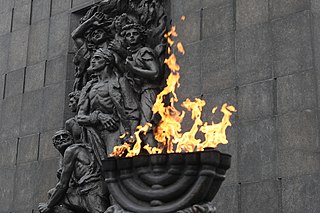
The history of the Jews in Poland dates back at least 1,000 years. For centuries, Poland was home to the largest and most significant Ashkenazi Jewish community in the world. Poland was a principal center of Jewish culture, because of the long period of statutory religious tolerance and social autonomy which ended after the Partitions of Poland in the 18th century. During World War II there was a nearly complete genocidal destruction of the Polish Jewish community by Nazi Germany and its collaborators of various nationalities, during the German occupation of Poland between 1939 and 1945, called the Holocaust. Since the fall of communism in Poland, there has been a renewed interest in Jewish culture, featuring an annual Jewish Culture Festival, new study programs at Polish secondary schools and universities, and the opening of Warsaw's Museum of the History of Polish Jews.

Ignacy Jan Paderewski was a Polish pianist, composer and statesman who was a spokesman for Polish independence. In 1919, he was the nation's prime minister and foreign minister during which he signed the Treaty of Versailles, which ended World War I.
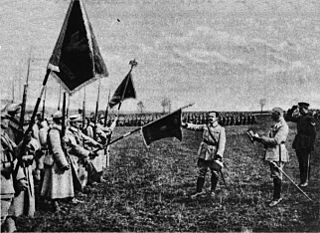
The Blue Army, or Haller's Army, was a Polish military contingent created in France during the latter stages of World War I. The name came from the French-issued blue military uniforms worn by the soldiers. The symbolic term used to describe the troops was subsequently adopted by General Józef Haller von Hallenburg himself to represent all newly organized Polish Legions fighting in western Europe.

Galician Jews or Galitzianers are members of the subgroup of Ashkenazi Jews originating and developed in the Kingdom of Galicia and Lodomeria and Bukovina from contemporary western Ukraine and from south-eastern Poland. Galicia proper, which was inhabited by Ruthenians, Poles and Jews, became a royal province within Austria-Hungary after the Partitions of Poland in the late 18th century. Galician Jews primarily spoke Yiddish.
Piotr Stefan Wandycz was a Polish-American historian. He was also the President of the Polish Institute of Arts and Sciences of America, and professor emeritus at Yale University, specializing in Eastern and Central European history.
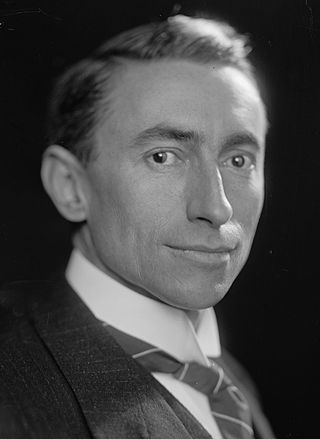
Hugh Simons Gibson was an American diplomat. He was actively involved in disarmament talks from 1925 to 1932. Throughout his career, he remained a leading proponent in the drive to establish a professional Foreign Service based on merit rather than personal wealth or political influence.

Antoni Listowski was a Polish military officer. After being a mayor general of the Imperial Russian Army, he became general in the Polish Armed Forces and took part in the Polish-Soviet War.

Controversies of the Polish–Soviet War, fought in 1919–20, concerning the behaviour of the military forces and crimes they committed. Each side charged the other with violations of international law in an effort to sway public opinion in the West, which was felt to be important for both sides.

The Vilna offensive was a campaign of the Polish–Soviet War of 1919–1921. The Polish army launched an offensive on April 16, 1919, to take Vilnius from the Red Army. After three days of street fighting from April 19–21, the city was captured by Polish forces, causing the Red Army to retreat. During the offensive, the Poles also succeeded in securing the nearby cities of Lida, Pinsk, Navahrudak, and Baranovichi.

The Pinsk massacre was the mass execution of thirty-five Jewish residents of Pinsk on April 5, 1919, by the Polish Army. The Polish commander "sought to terrorize the Jewish population" after claiming to being warned by two Jewish soldiers about a possible Bolshevik uprising. The event occurred during the opening stages of the Polish–Soviet War, after the Polish Army had captured Pinsk. The Jews who were executed had been arrested while meeting in a Zionist center to discuss the distribution of American relief aid; the meeting was described by the Poles as an "illegal gathering". The Polish officer-in-charge ordered the summary execution of the meeting participants without trial, and based on the information about the gathering's purpose that was founded on hearsay. The officer's decision was defended by high-ranking Polish military officers, but was widely criticized by international public opinion.

Aleksander Narbutt-Łuczyński was a Polish lawyer and military officer, a brigadier general of the Polish Army and a veteran of both the Polish-Bolshevik War and World War II. During the German-Soviet invasion of Poland in 1939 he commanded the rear troops of the Kraków Army.
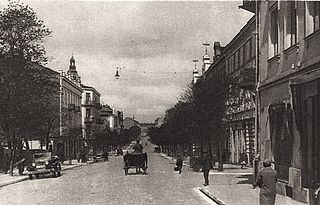
The Kielce pogrom of 1918 refers to the events that occurred on 11 November 1918, in the Polish city of Kielce located in current Świętokrzyskie Voivodeship. According to 1919 Report by Henry Morgenthau, Sr. who led the Mission of The United States to Poland; during Poland's fight for independence towards the end of the First World War, shortly after the Austro-Hungarian troops were evacuated from Kielce by their military command, the city authorities allowed local Jewish community to hold a rally at the Polish Theatre. The participants rallied behind the Jewish demand for political and cultural autonomy. According to one U.S. source, during the rally, anti-Polish speeches were also being delivered. A respected lawyer, Mr. Frajzyngier, who attempted to deliver a public address in Polish was booed. The angry audience shouted: "No Polish language here!" According to Stanisław Białek from the Jan Karski Society, the voices of protest sparked a rumour about the anti-Polish character of the meeting. As the meeting went on, a crowd of Polish onlookers gathered outside the theatre.

The Lwów pogrom was a pogrom perpetrated by Polish soldiers and civilians against the Jewish population of the city of Lwów. It happened on 21–23 November 1918, during the Polish–Ukrainian War that followed World War I.
The Polish National Department was a major organization of Polish-American Polish diaspora in United States around and after World War I. Originally the Polish Central Relief Committee and based in Chicago, it organized relief for war-torn and newly independent Second Polish Republic. Prominent activists included world-famous pianist and future prime minister of Poland, Ignacy Jan Paderewski and former Illinois Treasurer John F. Smulski.
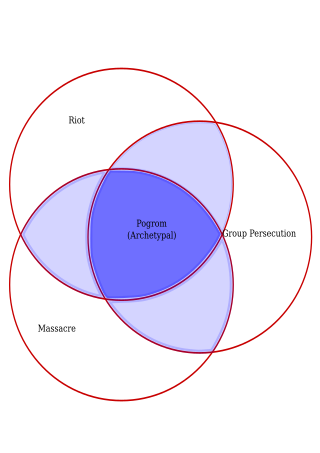
This article provides a list of definitions of the term pogrom. The term originated as a loanword from the Russian verb громи́ть, meaning "to destroy, to wreak havoc, to demolish violently". The events in Odessa during Holy Week in 1871 were the first to be widely called a "pogrom" in Russian, and the events of 1881–82 introduced the term into common usage throughout the world.

















